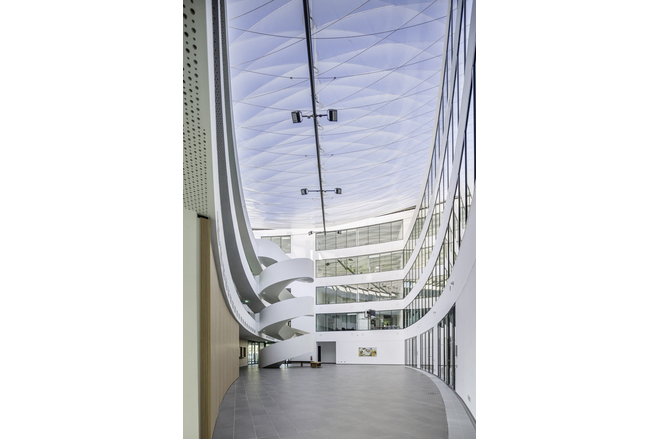AVIATION PIONIER
General information
-
Location address
Lilienthal Quarter, Braunschweig Airport
-
Location country
Germany
-
Year of construction
2018
-
Name of the client/building owner
Volksbank BraWo Projekt GmbH, Braunschweig/GER
- Function of building
-
Climatic zone
Temperate - cold winters and mild summers
-
Number of layers
multi-layer
-
Type of application of the membrane
covering
Description
The architect Hartmut Rüdiger bulged the three sides out, creating in this way a friendly, well-lit atrium in the middle of the building that forms the centrepiece of the Lilienthalhaus. It is open to the public and provides a space for events, exhibitions and lectures.
In order to provide a bright and friendly ambience in the atrium, the roofing was to be translucent. Due to fire safety requirements, however, a glass roof was ruled out. Using glass would also have required a correspondingly heavy substructure because of its high dead weight.
Rüdiger Architekten therefore consulted the membrane experts at formTL in Radolfzell. The engineers found a light alternative for the roof that met the set requirements – transparent ETFE foils. Like glass, this innovative material not only offers a high level of UV permeability and translucence, but at the same time it also guarantees the fire protection required by making the substructure considerably lighter.
The formTL engineers designed a triangular ETFE cushion over 400m2 to cover over the Lilienthalhaus. This solution has one particular feature: Due to tensile forces only, it was possible for the roof to be built with an extremely light substructure. Steel cables arranged in a rhombic shape and fixed to the perimeter tube around the building form the cushion and carry the loads. The supporting structure is thus almost invisible, giving the roofing the necessary lightness on the one hand and a great degree of elegance on the other. The triple-layer ETFE roof, which inclines towards the tip of the triangle, was elevated and anchored on top of the concrete structure. The inclination has given rise to further façade surfaces between the roof and the edge of the building which have likewise been realized using ETFE foil and integrated smoke and heat exhausting. The low structural weight of this lightweight structure is absolutely convincing, amounting to less than 20kg/m2 for the entire roofing of the atrium from the upper edge of the concrete structure.
In order to reduce heat gain due to sunlight, the outer layer of the cushtion was printed with an even pattern. The roofed atrium thus ensures that users of the Lilienthalhaus will have a space in which to spend high-quality time throughout the year.
Description of the environmental conditions
General comments, links
www.architektenruediger.de/architektenruediger/15_Architekten_Rudiger_Lilienthalhaus.html
Material of the cover
-
Cable-net/Fabric/Hybrid/Foil
Foil
Main dimensions and form
Duration of use
-
Temporary or permanent structure
Permanent
-
Design lifespan in years
31-..
Involved companies
-
Architects
Hartmut Rüdiger
-
Engineers
form TL ingenieure für tragwerk und leichtbau gmbh
Editor
-
Editor
Evi Corne



